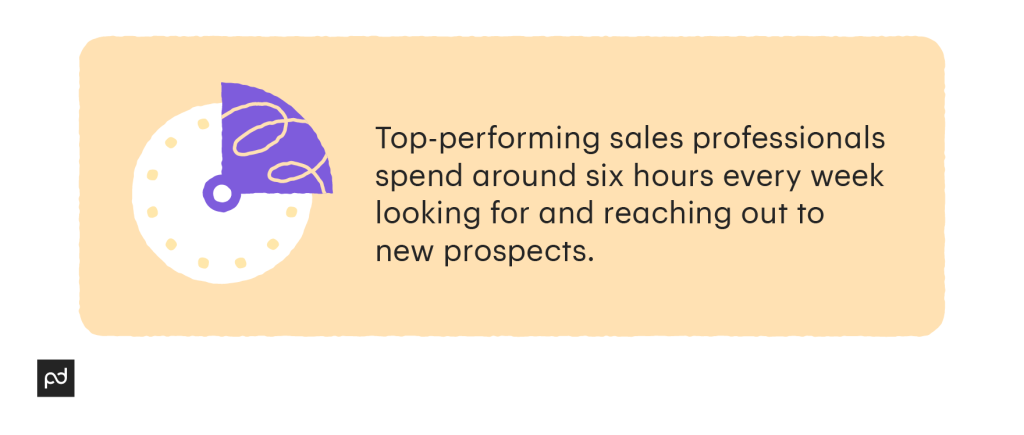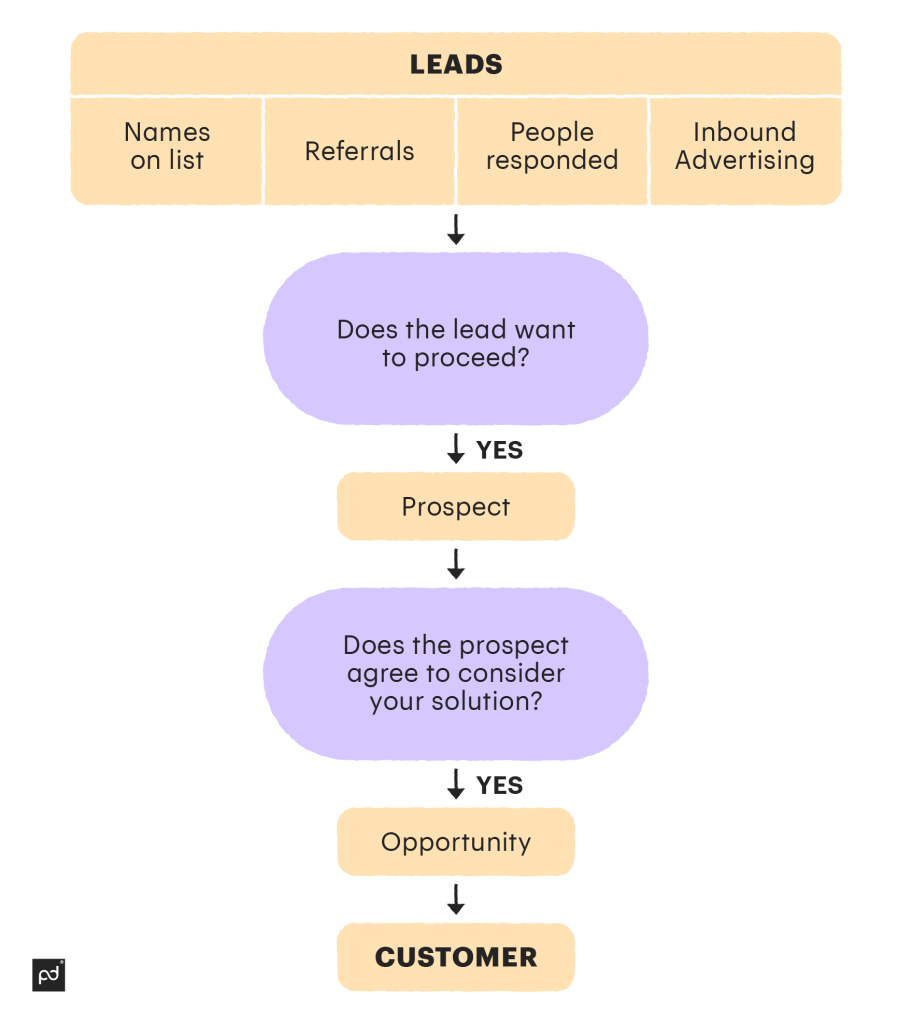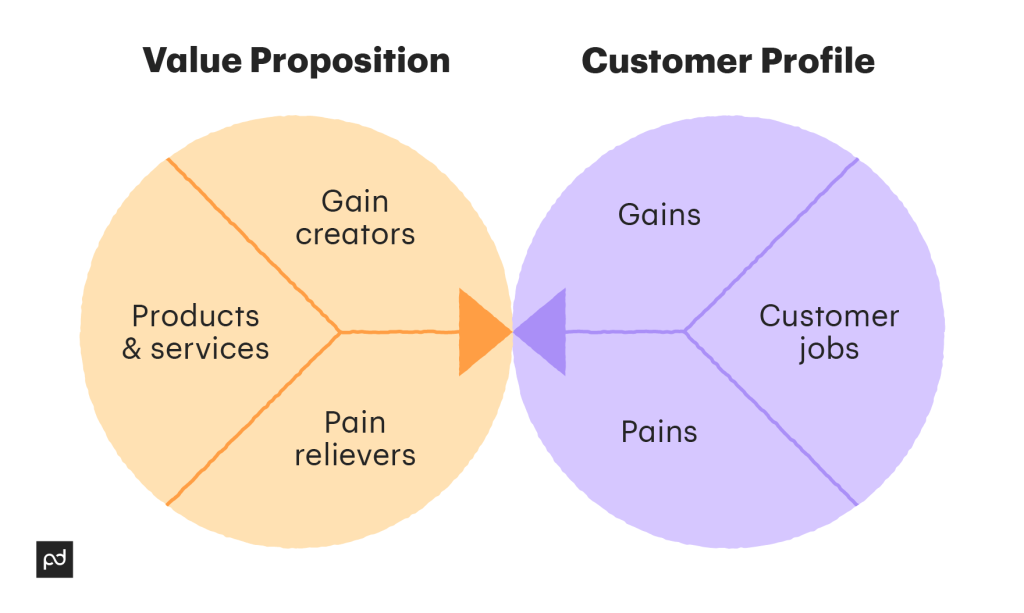Sales prospecting acts as the first stage in the sales process.
B2B sales organizations may often find that this process is highly time-consuming and requires significant investments in manual labor.

In many cases, just initiating the first contact doesn’t deliver any business growth. And poorly managed prospecting lists will result in seller fatigue.
In this article, we share how leads, prospects, and customers form the backbone of an effective sales process, enabling sales teams to tackle fatigue and sometimes mundane work.
You’ll also find a roster of valuable prospecting techniques and an in-depth look into what makes for a good prospective customer.
B2B sales prospecting in a nutshell
Prospecting isn’t the same as lead generation, though it is quite close.
Prospecting is the process of finding leads that are a good fit for your product or service offering.
At a high level, all prospecting methods can be divided into two buckets: inbound and outbound.
The inbound route leans on different outreach efforts: content marketing, social media marketing (often using LinkedIn as the most popular professional social media), email-drip campaigns that are usually within the purview of the marketing department, and any sales pitches, as well.
And the outbound sales are driven by the proactive efforts of the sales reps who look for potential buyers via various methods like cold calls and emails.
An ideal customer profile (ICP) describes what the most fitting potential buyers should look like. The more detailed and accurate your ICP is, the more resultative your sales will be.
Irrespective of which type, your salespeople look to obtain qualified leads that match the ICP.
Developing your ICP isn’t that hard, but it will immediately empower your company to improve the prospecting KPIs and look for more fitting candidates.
Sales leads vs. prospects vs. customers

Potential customers that have just been generated are referred to as leads.
We know that they have an interest in your offerings since they’ve filled out a form or furnished an email, but there’s not that much more information about them yet available.
Sales reps generally receive the results of the lead generation process as a list of sales leads in their CRM so that they can qualify them and determine how valuable they are to the business.
The lead qualification process may require reps to reach out to the leads and ask a bunch of qualification questions.
When your potential clients can see a good demand-offer fit, such leads are identified as prospects.
Prospective customers (or simply prospects) show more interest, have the needed budget, and check off other metrics that your business cares about.
Naturally, there’s no guarantee that prospects will convert to revenue-generating customers, but it’s much more likely when compared to early-stage leads.
Doing pitches, handling objections, and going through alignments with decision-makers will result in some deals being closed successfully, while other occasions see potential customers fall through the cracks.
Though the closing ratio is highly impacted by the seller’s skills and insights, the quality of the prospecting list is paramount.
Building a powerful prospective customers list
Investing time and effort into building a prospecting list pays off, as your sales team receives better leads that can be converted into closed deals, and do so more quickly.
Small businesses may start by collecting simple lists of leads at trade shows, networking events, and other initiatives.
When you only have a name and telephone number, enriching your lead entry is beneficial, as it will empower more effective qualification and segmentation.
Consider using an automation SaaS and hiring external assistants who can enrich your prospecting list and add up the missing data.
Keeping your prospecting database dynamic is another winning technique.
Whatever your B2B niche, the landscape is changing fast with companies going through M&As, purchasing decision-makers getting promoted or leaving the company, and new projects being kicked off all the time.
According to an MIT report, companies on average lose up to a quarter of their revenues due to inaccurate (and sometimes outdated) entries, and that data decay may hurt your prospecting efforts for those companies that deal with lengthy sales cycles.
A good way to stay dynamic is to set up a sales SaaS solution to track triggering events/buying signals.
These are the events that result in your prospect(s) becoming more receptive to your pitches, as the software ensures that you stay relevant to your lead and create an in-context narrative for reaching out.
Going after richer data enablement will allow your sales organization to stay competitive, as the sales industry is only getting increasingly data-driven.
What are the benefits of investing in your prospecting initiatives?
Just like sales teams, your prospective customer likely runs in-depth research campaigns before reaching out to the other side (vendors like yourself).
Randomly assigned cold calls aren’t as effective as they used to be.
Leads look for meaningful connections with sales reps that know the ins and outs of their product or service offering and can consult with prospects on all relevant details.
In this new reality, in-depth, multi-method, smart prospecting empowers your sales team with several major benefits.
Sales prospecting fuels your pipeline
Top performers always block off a certain time to prospect for new customers.
This helps deal with the ebbs and flows that businesses go through and hone prospecting skills.
Excessive reliance on inbound prospecting results in sellers losing power over their KPIs and the number of prospects in the pipeline.
Sales prospecting allows one to become a trusted advisor
Focusing on high-potential prospects and implementing elements of account-based marketing (ABM) brings a high level of granularity and familiarity with respect to their pain points and use cases.
Prospects usually interact with multiple sellers, but stick with those who share valuable insights and recommendations.
Trust is the key to a successful selling process — pushy salesmanship hasn’t been effective for a long time (and was never cool to begin with).
Sales prospecting boosts your performance
With an effective lead qualification process, your sellers know that the remaining opportunities are worth their attention.
Combine this with in-context selling, leveraging buying signals, and triggering events.
Data enrichment for inbound leads helps filter out poorly matched prospects better, thanks to deeper insights into their needs and processes before your sales reps have made a phone call or sent a sales email. (You can find some excellent templates for this very thing right here.)
Sales prospecting promotes competitive analysis
Empowered by rich insights online, buyers can quickly move on to comparing competitive offers and their advantages.
Use cards with notes on competitive products or services and specific features so that you can identify your strengths and weaknesses.
Continuously running sales prospecting campaigns keeps you updated on any major changes in how rivals run their marketing and features operations.
Now that we’ve laid out the benefits that an effective prospecting process will bring to your sales team, let’s take a deeper look at the specific steps doing so includes.
Sales prospecting process
Building out an effective process to look for prospects and establish a mutual connection with them takes time and a large number of iterations.
The key is to have a detailed written description for your prospecting strategy, enabling your sales reps to look into distinct steps and identify ways to improve their execution.
Step 1: Research prospects comparatively
The best way to determine how valuable a prospect may be to your company is to compare them against other prospective customers.
Consider implementing the weights for each factor and calculating the overall final values that make up your ideal customer profile.
In other words, distill down the ICP.
Step 2: Identify the value proposition

Consider how your product or service can meet their specific needs. Look into any public information on their past projects and ongoing initiatives.
Push the envelope with an ABM-driven approach and document the need-solution pairs for potential reuse with new leads.
Step 3: Develop a personalized pitch
Based on your findings in the previous step, create a highly pinpointed pitch that syncs with their pain points and delivers a timely and relevant solution.
For example, use the AIDA formula to package your narrative and engage with your contacts within that organization.
Step 4: Engineer an effective first touch
Contrary to the widely held opinions, B2B buyers are generally open to being contacted by sellers at the start of their buying journey.
These buyers seek insights and assistance when making specialized decisions on their actions involving your business niche.
As we’ve talked about above, leveraging the trigger events can allow you to stay relevant to prospective clients and extend your assistance at the right time.
Step 5: Iterate to improve prospecting
Engage your salespeople to experiment with various ways for optimal segmentation and reaching out.
Compare the outputs from different data enrichment methods and solutions to figure out what works best for your niche.
The more iterations you run, the more insights about smoother customer relationships you’ll garner for your ICP. Let’s talk about that.
Building your ideal customer profile
Although each sales process is unique, there are many universal markers of lucrative opportunities. Here are the boxes that each prospective client should check.
But, before starting, make sure you’re aware of the differences between ICPs and buyer personas.
Awareness of the pain point
Those leads that don’t even realize their need for your product or service are extremely hard to sell to.
Always add them to the email drip campaign and keep in touch at a minimal cost while highlighting the leads that have a sense of what they need.
Availability of sufficient budgets
Many sales professionals don’t want to talk money in their first interactions with their prospective customers.
And buyers always want to learn about the price tag as soon as they can. Though it might sound counter-productive, you’re better off aligning the numbers sooner than later.
This will result in many leads leaving the funnel at the top, but it’ll also free your hands up for more interactions with worthy prospects.
Match between the need and offers
Prospecting is all about finding the matches in what your leads are looking for and what you can offer.
Whenever you tap into a new target audience segment, use a new tack to package your product or service, and offer a solution to their unique pain points.
Enrich your ICP with each new use case and promotional tactic.
Authority
Set up a game plan for interacting with gatekeepers and decision-makers.
Even though a specific contact in a company might not have the full authority to make a final decision, they can introduce you to higher-level officials.
The key is to have an “authority map” on your hands for effective negotiations.
Trust and brand awareness
Though a lead might have a highly motivational pain point to be dealt with, they are surely talking with multiple providers.
And they might be more drawn toward popular brands and the teams behind them. Counteract this with end-to-end branding packaging and leaning on your goodwill and case studies.
Buyers always process information more favorably when receiving it via storytelling and success stories.
Urge to buy
Some prospective customers might linger in your sales pipeline for lengthy periods, unwilling to take the next steps.
A good decision is to develop methods and strategies for determining how close the buyer is to the final decision and identify these markers in your ICP.
Now that we’ve talked about the underlying process and ways to build out a detailed ICP, we’ll look into the prospecting techniques that will empower your sales practices even more.
Best prospecting techniques
Always test out new methods and techniques within your sales team and consider the feedback from sales reps and managers.
Top-down methods aren’t effective and might result in resentment and loss of control over the KPIs and goals.
Only those sales reps who own their processes feel motivated to achieve targets and grow the business together.
Below, we present some collaborative prospecting methods:
1. Integrate inbound and outbound prospecting
An effective CRM implementation allows you to track and signal any actions that your leads take when interacting with your assets.
Leveraging such triggers, sales reps are more empowered to deliver pinpointed and highly relevant sales messaging.
A great way to win hearts and minds is through educating and by raising awareness.
Use a document management system like PandaDoc to develop educational materials based on queries and discussions with your leads and stakeholders.
Publish reports, whitepapers, and case studies to draw warm traffic from online sources and always have ready-to-use documents on hand.
2. Leverage referrals
Word of mouth always has a paramount effect on sales decisions, both in B2C and B2B markets.
The performance sales teams always seek to awe and excel so that they can set up the groundwork for subsequent referral requests.
Happy managers and stakeholders are happy to share your message with other prospective customers and refer them to you whenever they deal with a similar pain point.
A referral program can boost your success in obtaining valuable referrals, as your existing customer base might need just a small nudge toward engaging their contacts in other companies.
3. Follow-up is king
Your prospects are busy, constantly dealing with various needs and managing projects.
Your email might easily fall through the cracks even though a buyer may be highly motivated to successfully finish the buying process.
Following up on your emails and calls is an easy and effective way to grow your lead-to-prospect ratio.
Avoid acting like a “professional robot” and always equip your follow-up with valuable marketing assets.
This will demonstrate to your prospect that you are actively trying to figure out why they have stalled or appear stuck within the sales funnel — and how to best “unstick” them.
Play with different cadences and determine an ideal number of touchpoints. In many cases, 6 follow-ups done within 20-30 days is a good way to start.
4. Use video to demonstrate commitment
While other sales prospectors may actively use written documents, you can stand apart from the competition with custom-made videos.
Going this route, it’s much more about what you say as opposed to the quality of the videos being produced.
Stay true to your brand and share your vision on the points you’ve covered above. Avoid selling and always stick with a consultative tone in your messaging.
Collect a library of such videos and consider reusing them when talking to new leads.
5. Leverage active listening
Contrary to stereotypes, successful sales reps are keen on active listening as opposed to constantly talking and making leads fall in love with their product or service offering.
Ask open-ended questions and listen to what the lead has to say when answering. First, this allows you to quickly ascertain whether they match your ICP.
Second, you’ll be able to learn about their pain points, use cases, and other details of their business.
The more knowledgeable you are about their circumstances, the easier it’ll be for you to rework your content marketing assets to check off all of their “want-to-have” and “need-to-have” boxes.
They will grow to believe that your product or service offering is genuinely a good option when taking into account their unique conditions.
6. Avoid embellishment and competitor bashing
Embellishing the benefits of your offering might seem enticing as it will allow you to continue talking for a longer time.
However, the truth will come out at a certain point, as all decision-making processes are run by multiple stakeholders within your corporate customer.
All embellishments and illusions will get gradually deconstructed, and the real customer-offer fit becomes evident.
Instead, focus on your offer’s strengths and dig deeper into what your prospective customer has to say so that you can tie their unique pain points to offering features.
Never engage in bashing your competitors, as this would certainly avert almost any lead.
Acting in a disrespectful and demeaning manner toward your rivals paints you in a highly unattractive light.
The prospective customer would see this as a major red flag that signals potential problems in your TBD relationship down the line.
Always stay focused on your brand and the products or services you offer, sharing success stories and actively listening to what the lead has to say about their pain points.
Conclusion
By investing more time and effort in effective prospecting, you ensure that your sales pipeline is always full of qualified leads and that you can dedicate more time to pitches and conversations.
Yes, prospecting might seem like a highly chaotic process with unscheduled conversations, back-and-forth, and emotionally-driven decisions.
But you’ll benefit from introducing more structure by implementing a written strategy with detailed descriptions of steps and procedures.
Once these are done, you can automate successful workflows.
Stay true to your branding and keep on sharing success stories and case studies with your prospects. Leverage the power of referrals and word of mouth to enjoy a steady stream of pre-warmed prospects in your sales pipeline.
As the game of sales is changing and prospects are growing smarter and more educated, your team will benefit from integrating your inbound and outbound camps with one another.
By producing and publishing written and video assets on long-tail queries, your prospecting efforts will stay relevant and valuable to any leads interested in your niche.
Originally published October 20, 2017, updated December 19, 2022
Disclaimer
PandaDoc is not a law firm, or a substitute for an attorney or law firm. This page is not intended to and does not provide legal advice. Should you have legal questions on the validity of e-signatures or digital signatures and the enforceability thereof, please consult with an attorney or law firm. Use of PandaDocs services are governed by our Terms of Use and Privacy Policy.


